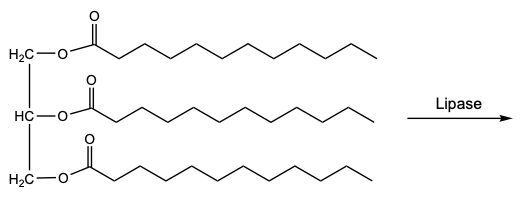In this video, we're going to take a look at a triacylglycerol reaction in the form of hydrolysis. Now, hydrolysis can be either acidic or basic. In this first video, we're going to look at acid-catalyzed hydrolysis. Now, under this type of reaction, an ester bond is hydrolyzed to create a glycerol molecule and three fatty acids. Now, here we're going to say it occurs stepwise in the presence of a strong acid. The acids are typically hydrochloric acid or sulfuric acid. When we say, stepwise, that means that all three fatty acids don't come off all at once. First, we do hydrolysis of the first ester linkage to break off the first fatty acid, then the second one occurs, and then the third one occurs. In this illustration here, we're going to show our final products as having three fatty acids. We're going to know that they all didn't come off all at once. This is the end result of going through three successions of acid-catalyzed hydrolysis to get rid of all three fatty acids.
Now, here if we take a look, we have our ester linkages here in red, we're using water and H+. Remember, hydrochloric acid and sulfuric acid are strong acids. In an aqueous environment, you typically see them represented as H+. You could still see H2O over HCl or H2O over H2SO4, but typically, again, we see these two strong acids in this form here. Now, what happens is our ester linkage is cut. So we cut these linkages. When we cut these linkages, the oxygen that is part of my glycerol molecule in blue, that oxygen gains a hydrogen. And in that way, we've created our OH groups for glycerol. So we've just created our glycerol molecule here. And then our fatty acid. Remember, a fatty acid has a hydrocarbon tail and then it has a carboxylic acid head. To make this into a carboxylic acid, we add OH to my carbonyl group. This is hydrolysis. We're using water to cut the ester linkage. We're basically adding water back. A H on the glycerol oxygens, OH on the carbonyl carbons.
Now, here besides acid-catalyzed hydrolysis, we have enzymatic hydrolysis. Now, this is a similar reaction done under milder conditions that instead uses the digestive enzyme lipase. So if we were to use the enzymatic approach, we'd use lipase instead of an acidic environment. This would still create our glycerol molecule and three fatty acids. We put it here because we're essentially making the same products. The pathway to get to them is different, but we're still making the same products at the end. So just remember, whether you're using acid-catalyzed hydrolysis or enzymatic hydrolysis, your products will be a glycerol molecule and three fatty acids.



